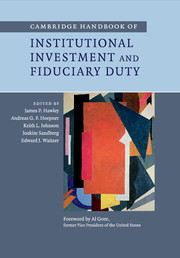17 results
1 - Introduction
-
-
- Book:
- Cambridge Handbook of Institutional Investment and Fiduciary Duty
- Published online:
- 05 April 2014
- Print publication:
- 10 April 2014, pp 1-6
-
- Chapter
- Export citation
Part I - Fiduciary duty: a global outlook
-
- Book:
- Cambridge Handbook of Institutional Investment and Fiduciary Duty
- Published online:
- 05 April 2014
- Print publication:
- 10 April 2014, pp 7-8
-
- Chapter
- Export citation
Part II - Fiduciary duty and the landscape of institutional investment
-
- Book:
- Cambridge Handbook of Institutional Investment and Fiduciary Duty
- Published online:
- 05 April 2014
- Print publication:
- 10 April 2014, pp 87-88
-
- Chapter
- Export citation
List of tables
-
- Book:
- Cambridge Handbook of Institutional Investment and Fiduciary Duty
- Published online:
- 05 April 2014
- Print publication:
- 10 April 2014, pp xii-xii
-
- Chapter
- Export citation
List of figures
-
- Book:
- Cambridge Handbook of Institutional Investment and Fiduciary Duty
- Published online:
- 05 April 2014
- Print publication:
- 10 April 2014, pp xi-xi
-
- Chapter
- Export citation
Part V - Beneficiaries’ roles and viewpoints
-
- Book:
- Cambridge Handbook of Institutional Investment and Fiduciary Duty
- Published online:
- 05 April 2014
- Print publication:
- 10 April 2014, pp 335-336
-
- Chapter
- Export citation
Frontmatter
-
- Book:
- Cambridge Handbook of Institutional Investment and Fiduciary Duty
- Published online:
- 05 April 2014
- Print publication:
- 10 April 2014, pp i-vi
-
- Chapter
- Export citation
List of contributors
-
- Book:
- Cambridge Handbook of Institutional Investment and Fiduciary Duty
- Published online:
- 05 April 2014
- Print publication:
- 10 April 2014, pp xiii-xv
-
- Chapter
- Export citation
Index
-
- Book:
- Cambridge Handbook of Institutional Investment and Fiduciary Duty
- Published online:
- 05 April 2014
- Print publication:
- 10 April 2014, pp 478-493
-
- Chapter
- Export citation
Foreword
-
- Book:
- Cambridge Handbook of Institutional Investment and Fiduciary Duty
- Published online:
- 05 April 2014
- Print publication:
- 10 April 2014, pp xvi-xviii
-
- Chapter
- Export citation
Part III - Challenging conventional wisdom on fiduciary duty
-
- Book:
- Cambridge Handbook of Institutional Investment and Fiduciary Duty
- Published online:
- 05 April 2014
- Print publication:
- 10 April 2014, pp 169-170
-
- Chapter
- Export citation
Contents
-
- Book:
- Cambridge Handbook of Institutional Investment and Fiduciary Duty
- Published online:
- 05 April 2014
- Print publication:
- 10 April 2014, pp vii-x
-
- Chapter
- Export citation
Part VI - Fiduciary duty and governance
-
- Book:
- Cambridge Handbook of Institutional Investment and Fiduciary Duty
- Published online:
- 05 April 2014
- Print publication:
- 10 April 2014, pp 389-390
-
- Chapter
- Export citation
2 - The public fiduciary: a Canadian perspective
-
-
- Book:
- Cambridge Handbook of Institutional Investment and Fiduciary Duty
- Published online:
- 05 April 2014
- Print publication:
- 10 April 2014, pp 9-19
-
- Chapter
- Export citation
Part IV - Towards a broader interpretation of fiduciary duty
-
- Book:
- Cambridge Handbook of Institutional Investment and Fiduciary Duty
- Published online:
- 05 April 2014
- Print publication:
- 10 April 2014, pp 263-264
-
- Chapter
- Export citation

Cambridge Handbook of Institutional Investment and Fiduciary Duty
-
- Published online:
- 05 April 2014
- Print publication:
- 10 April 2014
International Securities Regulation: Coping with the “Rashomon Effect”
-
- Journal:
- Proceedings of the ASIL Annual Meeting / Volume 88 / 1994
- Published online by Cambridge University Press:
- 28 February 2017, pp. 400-409
- Print publication:
- 1994
-
- Article
- Export citation



